Lesson 27.1 introduced polar coordinates and Lesson 27.2 investigated the graphs of polar equations. This lesson explores finding the area bounded by polar graphs.
Finding the Area Bounded by Polar Graphs
The area of the region between the origin and the curve r = f(
![]() ) for
) for
![]() is given by the definite integral
is given by the definite integral
This definite integral can be used to find the area of the region enclosed by the cardioid
r = 2(1 + cos
![]() ).
).
The complete graph of this function is plotted using the interval
![]() , so the area is given by the definite integral
, so the area is given by the definite integral
The integral may be evaluated on your TI-83.
-
Enter
 on the Home screen.
on the Home screen.
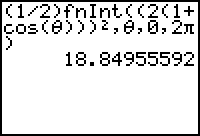
The area enclosed by the cardioid is approximately 18.8496 square units. The exact area is 6
![]() square units.
square units.
27.3.1 Find the area enclosed by the curve r = 2 on the interval
![]() . Click here for the answer.
. Click here for the answer.
Finding the Area Between Two Polar Curves
The area bounded by two polar curves where
![]() on the interval
on the interval
![]() is given by
is given by
This definite integral can be used to find the area that lies inside the circle r = 1 and outside the cardioid r = 1 – cos
![]() .
.
First illustrate the area by graphing both curves.
- Set r1 = 1.
-
Set r2 = 1 – cos(
 ).
).
-
Use a [0, 2
 ,
,
 /24] x [-4, 4, 1] x [-3, 3, 1] viewing window
/24] x [-4, 4, 1] x [-3, 3, 1] viewing window
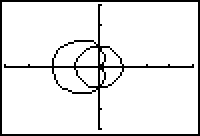
The area inside the circle and outside the cardioid lies in the first and fourth quadrants.
To find the area between the curves you need to know the points of intersection of the curves. The TI-83 can display coordinates in Polar form.
-
Press
 [FORMAT], which is above
[FORMAT], which is above
 , to open the Format menu and select PolarGC (Polar Graphing Coordinates).
, to open the Format menu and select PolarGC (Polar Graphing Coordinates).
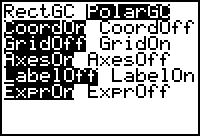
- Return to the graph and Trace to the first point of intersection.
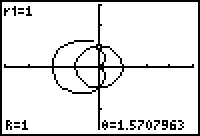
The first point of intersection occurs when
![]() .
.
- Trace to find the second point of intersection.
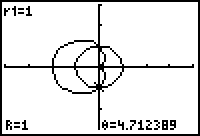
The second point of intersection occurs when
![]() .
.
|
|||
|
|
|||
The two points of intersection are at
![]() and
and
![]() . However, the values of
. However, the values of
![]() in the interval
in the interval
![]() correspond to the parts of the graphs that are in quadrants II and III. We want the area bounded by the graphs in quadrants IV and I. In order to obtain the proper limits of integration notice that the polar point
correspond to the parts of the graphs that are in quadrants II and III. We want the area bounded by the graphs in quadrants IV and I. In order to obtain the proper limits of integration notice that the polar point
![]() is the same as
is the same as
![]() so the desired area is found by letting
so the desired area is found by letting
![]() range from
range from ![]() /2 to
/2 to
![]() /2.
/2.
The definite integral that gives the area is
-
Enter
 .
.
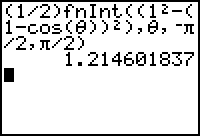
The area is approximately 1.215 square units.
27.3.2 Find the area of the region inside the circle r = 3 sin
![]() and outside the cardoid r = 1 + sin
and outside the cardoid r = 1 + sin
![]() . Click here for the answer.
. Click here for the answer.